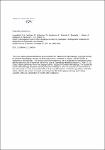Novel cytomegaloviruses in free-ranging and captive great apes: phylogenetic evidence for bidirectional horizontal transmission
Leendertz, Fabian
Deckers, Merlin
Schempp, Werner
Lankester, Felix
Boesch, Christophe
Mugisha, Lawrence
Dolan, Aidan
Gatherer, Derek
McGeoch, Duncan J.
Ehlers, Bernhard
Wild great apes often suffer from diseases of unknown aetiology. This is among the causes of population declines. Because human cytomegalovirus (HCMV) is an important pathogen, especially in immunocompromised individuals, a search for cytomegaloviruses (CMVs) in deceased wild and captive chimpanzees, gorillas and orang-utans was performed. By using a degenerate PCR targeting four conserved genes (UL54-UL57), several distinct, previously unrecognized CMVs were found for each species. Sequences of up to 9 kb were determined for ten novel CMVs, located in the UL54-UL57 block. A phylogenetic tree was inferred for the ten novel CMVs, the previously characterized chimpanzee CMV, HCMV strains and Old World and New World monkey CMVs. The primate CMVs fell into four clades, containing New World monkey, Old World monkey, orang-utan and human CMVs, respectively, plus two clades that each contained both chimpanzee and gorilla isolates (termed CG1 and CG2). The tree loci of the first four clades mirrored those for their respective hosts in the primate tree, suggesting that these CMV lineages arose through cospeciation with host lineages. The CG1 and CG2 loci corresponded to those of the gorilla and chimpanzee hosts, respectively. This was interpreted as indicating that CG1 and CG2 represented CMV lineages that had arisen cospeciationally with the gorilla and chimpanzee lineages, respectively, with subsequent transfer within each clade between the host genera. Divergence dates were estimated and found to be consistent with overall cospeciational development of major primate CMV lineages. However, CMV transmission between chimpanzees and gorillas in both directions has also occurred.
No license information
Related Items
Show related Items with similar Title, Author, Creator or Subject.
-
2009-11-18ZeitschriftenartikelDeletion of the rat cytomegalovirus immediate-early 1 gene results in a virus capable of establishing latency, but with lower levels of acute virus replication and latency that compromise reactivation efficiency. Sandford, Gordon R.; Schumacher, Uwe; Ettinger, Jakob; Brune, Wolfram; Hayward, Gary S.; Burns, William H.; Voigt, SebastianThe IE1 and IE2 proteins encoded by the major immediate-early (MIE) transcription unit of cytomegaloviruses are thought to play key roles in the switch between latent and lytic cycle infection. Whilst IE2 is essential for ...
-
2009-11-18ZeitschriftenartikelDeletion of the rat cytomegalovirus immediate-early 1 gene results in a virus capable of establishing latency, but with lower levels of acute virus replication and latency that compromise reactivation efficiency Sandford, Gordon R.; Schumacher, Uwe; Ettinger, Jakob; Brune, Wolfram; Hayward, Gary S.; Burns, William H.; Voigt, SebastianThe immediate-early 1 (IE1) and IE2 proteins encoded by the major immediate-early (MIE) transcription unit of cytomegaloviruses are thought to play key roles in the switch between latent- and lytic-cycle infection. Whilst ...
-
2009-11-26ZeitschriftenartikelHigh genotypic diversity and a novel variant of human cytomegalovirus revealed by combined UL33/UL55 genotyping with broad-range PCR Deckers, Merlin; Hofmann, Jörg; Kreuzer, Karl-Anton; Reinhard, Henrike; Edubio, Abigail; Hengel, Hartmut; Voigt, Sebastian; Ehlers, BernhardThe known strains of human cytomegalovirus (HCMV) represent genotypic variants of a single species, and HCMV genotypic variability has been studied in order to reveal correlations between different disease patterns and the ...

